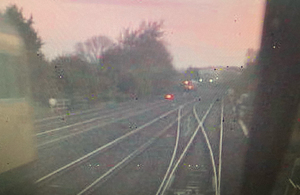Signal passed at danger and near miss at Sileby Junction
Investigation into a signal passed at danger and near miss at Sileby Junction, Leicestershire, 5 May 2021.

CCTV image from the rear of the train of empty coaches, showing the rail grinding train, travelling towards the junction, on the left (courtesy of East Midlands Trains)
At around 05:29 hrs on 5 May 2021, a train made up of machines used for reprofiling (grinding) rails, travelling on the down slow line near Sileby, passed signal LR477 at danger by about 350 metres. The signal was at danger because a train of empty coaches, travelling in the opposite direction, was crossing the down slow line ahead to move from the up fast to the up slow line.
The rail grinding train came to a stop fouling the junction over which the train of empty coaches had passed, less than ten seconds earlier.
RAIB’s preliminary examination has found that there were no technical faults in the trains or the signalling equipment. The brakes of the rail grinding train were applied by its driver and by intervention of the train protection and warning system (TPWS), but this intervention did not stop the train within the safe overrun distance, and allowed it to reach the conflict point at the junction.
Our investigation will seek to identify the sequence of events which led to the incident. It will also consider:
-
The management of the grinding train driver’s competence and fitness
-
The design of the signalling on the Leicester to Loughborough section of line
-
The effectiveness of TPWS in circumstances where train braking rates are lower than those used in calculations relating to the design of the system
-
Any relevant underlying factors, including the rail industry’s response to RAIB’s recommendations made in previous reports involving train driver fatigue management
Our investigation is independent of any investigation by the railway industry or by the industry’s regulator, the Office of Rail and Road.
We will publish our findings, including any recommendations to improve safety, at the conclusion of our investigation. This report will be available on our website.
You can subscribe to automated emails notifying you when we publish our reports